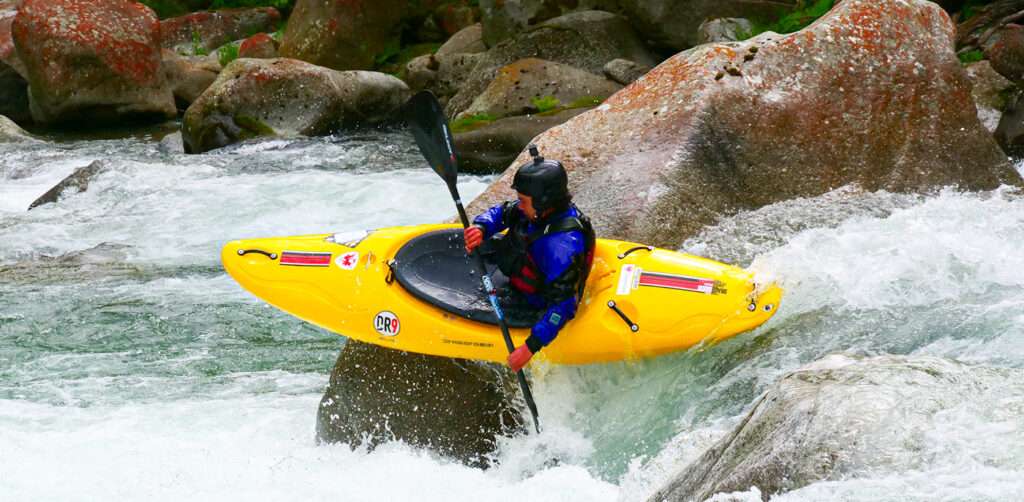Whitewater kayaking involves a number of different pieces of equipment that, in effect, serve as extensions of the body. This creates a layered human-machine interface situation. An ergonomic approach to whitewater kayaking requires addressing each layer.
Human-Machine Interfaces
The first human-machine interface is between your lower body and the inside of the kayak. The kayak acts as an extension to the body so the second interface is between the kayak/body combination and the river. The third interface is between your hands and the paddle. Much like the kayak, the paddle acts as an extension of the arms, so the fourth interface is between the paddle/arm combination and the river.
There are also some secondary interfaces that develop while the kayak is being carried or secured on a transport. This article will only examine the interfaces between the user and the kayak while paddling.
There are several points of contact that occur as the body sits in the kayak. The feet, knees, thighs, hips, butt, and lower back constitute the primary points of contact. These points are important for keeping a good posture and are the most likely points of discomfort, irritation or injury.
Posture
Proper kayaking posture is relatively simple. Sit up straight. Do not lean back. Do not lean forward. Keep the knees slightly bent for good circulation and keep some space around them for leg movement. Grip the thigh brace with your thigh. Keep the shoulders back and chest spread for paddling.
Boat Features
Your feet can be supported in several different ways including movable blockheads, foam inserts, movable pegs, or simply the shape of the plastic at the end of the boat. It is important to have proper support without it being so tight in the kayak that it becomes uncomfortable. Having proper foot support leads to better boat control, a more upright posture, and a good snug fit within the boat.
While there are no specific inserts within the kayak that address knee placement, the shape of the hull where your knees are is crucial towards maintaining comfort and control. The shape of the thigh braces and boat dictate the amount of space to for your knees.
The thigh braces are adjustable curved pieces that slide along a track located along the cockpit of the kayak. These thigh braces are important for boat maneuverability (particularly when it comes to rolling back upright after flipping over) and comfort.
Properly fitted hip pads allow the kayak to move with your body. This is important when it comes to controlling the edges of your boat for maneuvers such as ferries, eddy turns, peel outs, surfing, etc. However, padding which is too tight restricts circulation in your legs which makes for a very uncomfortable day on the river.
Kayak seats vary tremendously from boat to boat. Comfort is the key factor in determining if a seat is right for you or not. Good padding makes it softer. Breathable material or ridges allow for water drainage and air circulation.
Some seats are movable, allowing you to position yourself forward or backwards along the cockpit. Some seats even have a foam insert positioned between your legs to keep you from sliding forward in the kayak and in the proper position. Personal preference should not be overlooked as you will be spending a lot of time in the seat.
The back brace is designed to be placed along your lower back to support proper posture. Often kayakers will want the brace loosened when they get in the boat and then tightened once in. This is great as long as you can still get out of your boat without loosening the strap in an emergency.
The type of padding and fabric used on the back brace is important. Abrasive fabrics can rub against your lower back causing a chaffing (a repetitive stress injury). Padding that sticks to your skin can also be quite irritable and prohibit airflow across the skin.
Paddling
The hand grips the paddle. That grip needs to be secure in a wet environment. Additional anti-slip guards are a plus.
Gloves are available, but are often considered “uncool” by fellow kayakers. If you do not want to wear them be prepared to develop blisters and calluses (more repetitive stress injuries) quickly.
You arms, wrists, and hands should not hit the side of the boat as you paddle. The width of the boat is important when choosing an ideal set-up. The ridges along the side of the kayak should not interfere with normal paddling technique. In most cases, the main reason you might encounter problems with this is not because the boat does not fit you properly but because of incorrect paddling technique.
Summary
Kayaking is one of the most exciting sports you may ever participate in, but without adequate boat outfitting, it can be painful and dangerous. The best way to find out what works best for you is to try a variety of different boats and get a feel for the setup that is most efficient for your body type.

